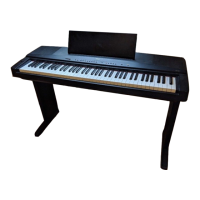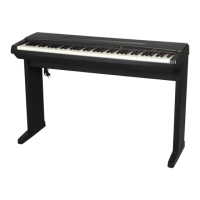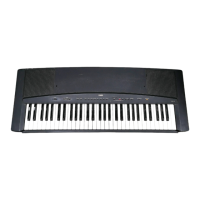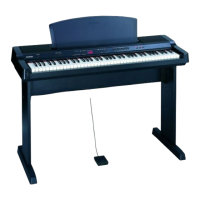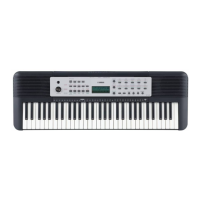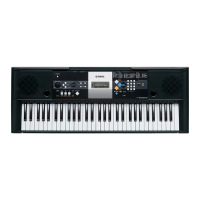Do you have a question about the Yamaha YPP-200 and is the answer not in the manual?
Information regarding the product's battery usage and safety.
Details on where to find the product's identification label.
Warning against unauthorized modifications to the unit.
Essential safety guidelines to prevent injury or damage.
Precautions for power, water, fire, and placement.
Guidance on connecting the instrument to other devices.
Cautions for handling and saving instrument data.
Introduction to the YPP-200 and its key features.
List of items supplied with the piano.
Operation of the power switch and master volume.
Details on DEMO, TRANSPOSE, FUNCTION, METRONOME, TEMPO, and selection buttons.
Buttons for preset songs and the user song recorder.
Buttons for selecting voices, reverb, effects, and touch sensitivity.
Description of PHONES, MIDI, PEDAL, OUTPUT, and DC IN jacks.
Instructions for connecting the AC power adapter.
Connecting to external audio systems via OUTPUT jacks.
Connecting MIDI devices and footswitches.
Connecting headphones and attaching the music stand.
Steps for turning on and setting the initial volume.
How to choose voices and utilize touch response.
Adding reverb and other effects to the sound.
How to engage, play, and exit voice demonstration mode.
Selecting and playing preset songs, including sequence/random modes.
Function to specify and repeat song sections.
Managing song parts and using Synchro/Soft Pedal start.
How to play two voices simultaneously.
Accessing advanced dual mode settings like balance and detune.
Choosing from ROOM, HALL 1, HALL 2, STAGE reverb.
Customizing the intensity of the reverb effect.
Choosing from CHORUS, PHASER, TREMOLO, DELAY effects.
Customizing the intensity of the selected effect.
Adjusting how hard keys must be played for volume.
Shifting the keyboard pitch up or down in semitones.
Using the built-in metronome for practice.
Setting the tempo for metronome and song playback.
Initial setup and steps to start recording.
How to initiate and cease recording.
Changing initial settings and erasing tracks.
Playing back recorded songs and controlling playback.
Using auto-start and footswitch control for playback.
General procedure for accessing and using functions.
Setting the master tuning frequency.
Choosing from different musical scale tunings.
Adjusting dual voice balance, detune, and octave shifts.
Setting effect depth, soft pedal mode, and reset.
Adjusting metronome volume and preset song part volume.
Introduction to MIDI settings and capabilities.
Managing local control and program change messages.
Managing control change messages and MIDI transpose.
Transmitting panel settings and dumping data.
Enabling backup for voice, MIDI, tuning, and pedal settings.
Explanation of Musical Instrument Digital Interface technology.
Types of MIDI messages and connection terminals.
Steps for connecting the YPP-200 to computers via various interfaces.
Restoring the instrument to its default factory settings.
Solutions for sound, footswitch, noise, and interference issues.
Descriptions of each available voice and its touch response.
Lists of available demonstration tunes and preset songs.
Reference for default values and backup configuration options.
Technical details of MIDI note and control change message formats.
Formats for program change and system exclusive messages.
Details on Universal Non-Realtime and XG messages.
Tables detailing MIDI parameter change data for system and effects.
Chart outlining transmitted and recognized MIDI messages.
Step 1: Connecting the stand bases to side boards.
Step 2: Securing angle brackets to the side boards.
Step 3: Connecting the back board to the stand structure.
Step 4 & 5: Positioning and fixing the keyboard onto the assembled stand.
Overview of keyboard, polyphony, effects, dimensions, and power.
Duties of the consumer for warranty service.
Conditions and damages not covered by the warranty.
Information regarding the product's battery usage and safety.
Details on where to find the product's identification label.
Warning against unauthorized modifications to the unit.
Essential safety guidelines to prevent injury or damage.
Precautions for power, water, fire, and placement.
Guidance on connecting the instrument to other devices.
Cautions for handling and saving instrument data.
Introduction to the YPP-200 and its key features.
List of items supplied with the piano.
Operation of the power switch and master volume.
Details on DEMO, TRANSPOSE, FUNCTION, METRONOME, TEMPO, and selection buttons.
Buttons for preset songs and the user song recorder.
Buttons for selecting voices, reverb, effects, and touch sensitivity.
Description of PHONES, MIDI, PEDAL, OUTPUT, and DC IN jacks.
Instructions for connecting the AC power adapter.
Connecting to external audio systems via OUTPUT jacks.
Connecting MIDI devices and footswitches.
Connecting headphones and attaching the music stand.
Steps for turning on and setting the initial volume.
How to choose voices and utilize touch response.
Adding reverb and other effects to the sound.
How to engage, play, and exit voice demonstration mode.
Selecting and playing preset songs, including sequence/random modes.
Function to specify and repeat song sections.
Managing song parts and using Synchro/Soft Pedal start.
How to play two voices simultaneously.
Accessing advanced dual mode settings like balance and detune.
Choosing from ROOM, HALL 1, HALL 2, STAGE reverb.
Customizing the intensity of the reverb effect.
Choosing from CHORUS, PHASER, TREMOLO, DELAY effects.
Customizing the intensity of the selected effect.
Adjusting how hard keys must be played for volume.
Shifting the keyboard pitch up or down in semitones.
Using the built-in metronome for practice.
Setting the tempo for metronome and song playback.
Initial setup and steps to start recording.
How to initiate and cease recording.
Changing initial settings and erasing tracks.
Playing back recorded songs and controlling playback.
Using auto-start and footswitch control for playback.
General procedure for accessing and using functions.
Setting the master tuning frequency.
Choosing from different musical scale tunings.
Adjusting dual voice balance, detune, and octave shifts.
Setting effect depth, soft pedal mode, and reset.
Adjusting metronome volume and preset song part volume.
Introduction to MIDI settings and capabilities.
Managing local control and program change messages.
Managing control change messages and MIDI transpose.
Transmitting panel settings and dumping data.
Enabling backup for voice, MIDI, tuning, and pedal settings.
Explanation of Musical Instrument Digital Interface technology.
Types of MIDI messages and connection terminals.
Steps for connecting the YPP-200 to computers via various interfaces.
Restoring the instrument to its default factory settings.
Solutions for sound, footswitch, noise, and interference issues.
Descriptions of each available voice and its touch response.
Lists of available demonstration tunes and preset songs.
Reference for default values and backup configuration options.
Technical details of MIDI note and control change message formats.
Formats for program change and system exclusive messages.
Details on Universal Non-Realtime and XG messages.
Tables detailing MIDI parameter change data for system and effects.
Chart outlining transmitted and recognized MIDI messages.
Step 1: Connecting the stand bases to side boards.
Step 2: Securing angle brackets to the side boards.
Step 3: Connecting the back board to the stand structure.
Step 4 & 5: Positioning and fixing the keyboard onto the assembled stand.
Overview of keyboard, polyphony, effects, dimensions, and power.
Duties of the consumer for warranty service.
Conditions and damages not covered by the warranty.
| Type | Digital Piano |
|---|---|
| Number of Keys | 88 |
| Touch Sensitivity | Hard/Medium/Soft/Fixed |
| Sound Engine | AWM Stereo Sampling |
| Polyphony | 32 |
| Voices | 10 |
| Effects | Reverb, Chorus |
| Recording | Yes |
| Metronome | Yes |
| Transpose | Yes |
| Tuning | Yes |
| Speakers | 12cm x 2 |
| Amplifier | 6W x 2 |
| Demo Songs | 10 |
| Built-in Songs | 50 |
| Pedals | Sustain |
| Connectivity | MIDI IN/OUT |

